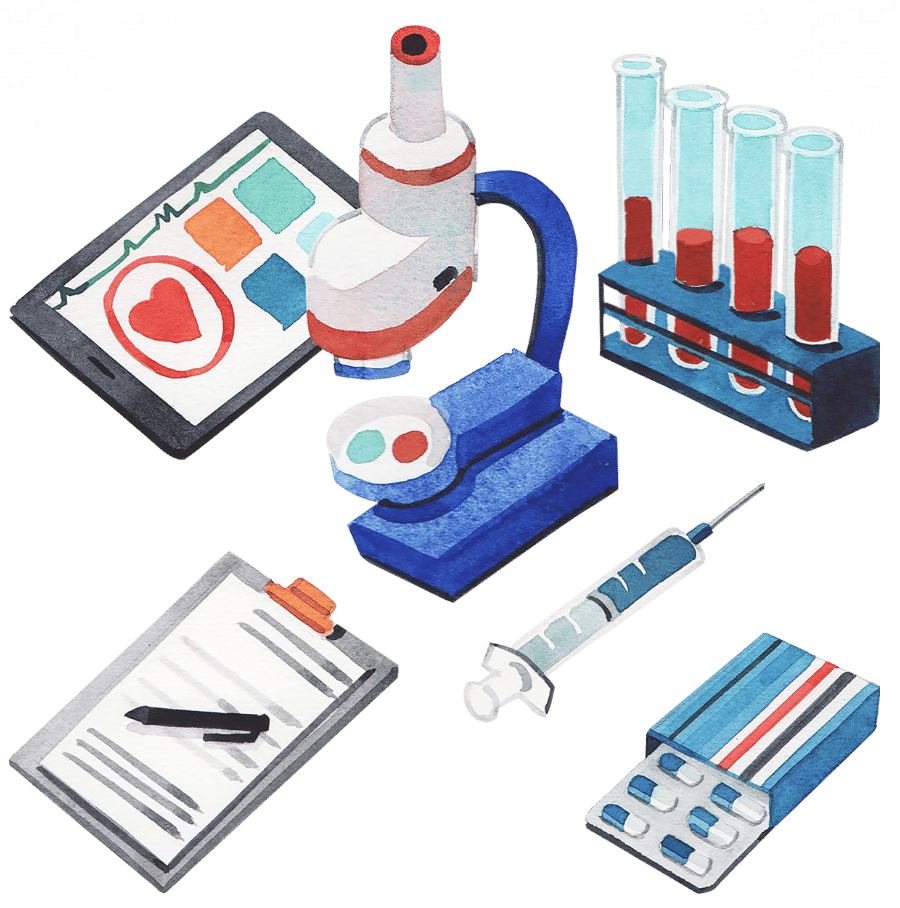Haematology
The most common hematology test, providing counts of RBCs, WBCs, and platelets, along with hemoglobin and hematocrit levels.
Red Blood Cells (RBCs)
Responsible for oxygen transport.
White Blood Cells (WBCs)
Involved in the immune response.
Platelets
Essential for blood clotting.
Hemoglobin
The protein in RBCs that carries oxygen.
Hematocrit
The percentage of blood volume occupied by red blood cells.
Coagulation factors
Proteins involved in blood clotting.
Common Tests
Complete Blood Count (CBC)
The most common hematology test, providing counts of RBCs, WBCs, and platelets, along with hemoglobin and hematocrit levels.
White Blood Cell Differential
Breaks down the different types of white blood cells (neutrophils, lymphocytes, monocytes, eosinophils, basophils).
Reticulocyte Count
Measures immature red blood cells, indicating bone marrow activity.
Erythrocyte Sedimentation Rate (ESR)
A non-specific test for inflammation.
Coagulation Tests
Such as Prothrombin Time (PT), Activated Partial Thromboplastin Time (aPTT), and D-dimer, which assess blood clotting ability.
Blood Smear Review
Microscopic examination of blood cells for abnormalities.
Conditions Diagnosed/Monitored
Discover our interconnected solutions designed for the diverse needs of MSMEs, Government, and large enterprises, ensuring seamless operations and sustained growth.
Anemia (various types)
Anemia is a condition in which the blood lacks healthy red blood cells, or the red blood cells don't have enough hemoglobin.
Leukemia and Lymphoma (blood cancers)
Leukemia and Lymphoma are two primary types of blood cancers, which originate in the blood-forming tissues or immune system cells.
Infections and inflammatory conditions
Infections and inflammatory conditions" are two broad categories of health issues that are very frequently encountered in medical practice and are often intertwined.
Bleeding Disorders
Bleeding disorders" are a group of conditions where the body's natural process of blood clotting (hemostasis) is impaired, leading to prolonged or excessive bleeding.
Clotting Disorders
"Clotting disorders," also known as thrombophilias or hypercoagulable states, are conditions where the blood has an increased tendency to form clots (thrombi) within blood vessels.
Bone Marrow Disorders
Bone marrow disorders are a diverse group of conditions that affect the bone marrow, which is the soft, spongy tissue found inside large bones.
Immunology
the study of the immune system, its structure, function, disorders, and how it protects the body from disease. In a diagnostic laboratory, the immunology department performs tests to assess the function of the immune system, detect infections, diagnose autoimmune diseases, and identify allergies.
Antibodies (Immunoglobulins)
Proteins produced by the immune system in response to specific antigens (foreign substances).
Antigens
Substances (e.g., from bacteria, viruses, allergens) that trigger an immune response.
Immune Cells
Specific types of white blood cells (e.g., T-cells, B-cells, NK cells) and their subsets.

Cytokines and Chemokines
Signaling molecules of the immune system.
Hematocrit
Antibodies that mistakenly target the body's own tissues.
Common Tests
Antibody Tests
To detect past or current infections (e.g., HIV antibodies, Hepatitis antibodies, COVID-19 antibodies).
Autoantibody Panels
To diagnose autoimmune diseases (e.g., ANA for lupus, RF for rheumatoid arthritis, anti-CCP).
Allergy Testing
Detecting specific IgE antibodies to allergens.
Complement System Assays
Measuring components of the immune system's complement pathway.
Immunoglobulin Levels
Quantifying IgG, IgM, IgA, IgE, IgD to assess immune status.
Flow Cytometry (for cell subsets)
Counting and characterizing different types of immune cells (e.g., CD4 counts in HIV patients, lymphocyte subset analysis for immunodeficiencies).
HLA Typing
For organ transplantation compatibility.
Conditions Diagnosed/Monitored
Discover our interconnected solutions designed for the diverse needs of MSMEs, Government, and large enterprises, ensuring seamless operations and sustained growth.
Infectious Diseases
Infectious diseases are illnesses caused by pathogenic microorganisms (germs) that invade the body, multiply, and cause harm.
Autoimmune Diseases
Autoimmune diseases are a group of conditions where the body's immune system, which is normally responsible for defending against foreign
Allergies and hypersensitivity reactions
Allergies and "hypersensitivity reactions" are terms that describe an overreaction of the immune system to substances that are typically harmless to most people
Primary and secondary immunodeficiencies
Primary and secondary immunodeficiencies refer to conditions where the body's immune system is weakened or compromised, making an individual more susceptible to infections
Monitoring of organ transplant patients
Monitoring of organ transplant patients is a critical and complex aspect of post-transplant care, essential for ensuring the long-term success of the transplanted organ and the overall health of the recipient.
Monitoring of certain cancers
Monitoring of certain cancers, like Multiple Myeloma, is a crucial aspect of oncology that relies heavily on diagnostic laboratory tests.
Interconnection in a Laboratory
Hematology and Immunology are often grouped together in laboratories because:
Blood is the primary specimen for many tests in both disciplines.
White blood cells are central to the immune system, so hematological analysis often provides initial clues for immunological investigations.
Many diseases have both a hematological component (affecting blood cells) and an immunological component (involving the immune system's response). For example, autoimmune hemolytic anemia involves both red blood cells and an autoimmune attack.
is a technology frequently used by both departments for cell analysis.


